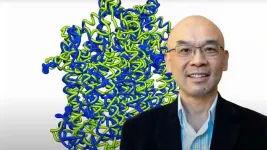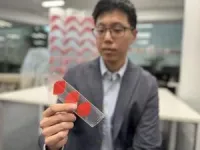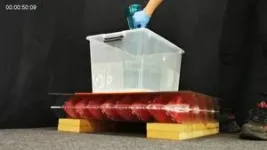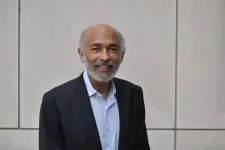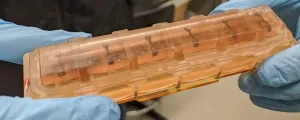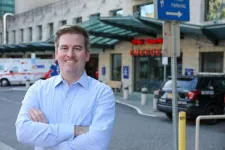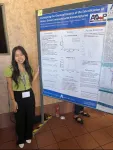(Press-News.org) A University of Missouri researcher has created a computer program that can unravel the mysteries of how proteins work together — giving scientists valuable insights to better prevent, diagnose and treat cancer and other diseases.
Jianlin “Jack” Cheng from Mizzou’s College of Engineering and his student, Nabin Giri, have developed a tool called Cryo2Struct that uses artificial intelligence (AI) to build the three-dimensional atomic structure of large protein complexes, work recently published in Nature Communications. The model uses data from pictures of frozen molecules captured by powerful microscopes, or cryo-electron microscopy (cryo-EM) images.
“Cryo-EM right now is a revolutionary, key technology for determining large protein structures and assemblies in cells,” said Cheng, a Curators’ Distinguished Professor of Electrical Engineering and Computer Science. “But building protein structures from Cryo-EM data is labor intensive and requires a lot of human intervention, making it time-consuming and hard to reproduce. Our technique is fully automated and generates more accurate structures than existing methods.”
Predicting proteins
To understand the significance of the work you have to know a bit about proteins and the decades-old struggle to understand them.
Proteins are the building blocks of life. They start as strings of amino acids that fold into three-dimensional shapes. Those shapes determine how a protein will function.
For more than 50 years, that folding process baffled researchers.
Cheng was among the first to apply deep learning, a type of AI, to the problem. In 2012, he demonstrated an AI-based model that proved deep learning could predict protein structures. The work paved the way for groundbreaking advancements, including Google’s AlphaFold, now considered the most accurate tool in the world for predicting protein structures.
But predicting a single protein structure is only half of the problem. In the real world, proteins work together as molecular machines that carry out complicated biological functions. Understanding protein interactions is critical because they determine how diseases develop and help scientists figure out how best to treat them.
Cracking the code
Cheng’s Cryo2Struct operates a little like a detective cracking a case without any clues.
The system analyzes cryo-EM images and identifies the individual atoms and their positions within a protein complex, even when there’s no prior knowledge of the structure. The system can then assemble these atoms into a complete 3D model of protein complexes, providing insights into how proteins function.
“Our technology enables scientists to determine and build a structure from cryo-EM data,” Cheng said. “Once you have that structure and understand its functions, you can design drugs to counter any faulty functions of a protein complex to make it function properly.”
In a related paper published in Chemistry Communications, Cheng and his student, Alex Morehead, explored a different AI method called diffusion model, modeling how molecular structures evolve from random noise into well-defined shapes. Those methods can help scientists generate and optimize small molecules, including drugs, and determine how and where those drugs bind to proteins.
“For instance, I have a drug, and I want to make it work better for some patients,” Cheng said. “Now I can use AI to change it and optimize it.”
Mizzou’s interdisciplinary resources helped make the breakthrough possible. Cheng is a researcher at NextGen Precision Health, where he has access to Cryo-EM and high-resolution electron microscopy.
“The opportunities at Mizzou to collaborate with other researchers and utilize state-of-the-art equipment are unparalleled,” he said. “At NextGen, we’re all working to advance highly individualized health care, and technologies like Cryo2Struct will help make that possible.”
END
Paving the way for new treatments
Mizzou researcher Jianlin “Jack” Cheng debuts tool to build 3D structure of protein complexes, giving scientists insights to prevent and treat disease.
2024-09-23
ELSE PRESS RELEASES FROM THIS DATE:
Dream discovery: Melatonin's key role in REM sleep revealed
2024-09-23
A significant breakthrough in the understanding of sleep mechanism opens new promise for treating sleep disorders and associated neuropsychiatric conditions: Scientists have pinpointed the melatonin receptor MT1 as a crucial regulator of REM (Rapid Eye Movement) sleep.
REM sleep is crucial for dreaming, memory consolidation, and emotional regulation. In the brain, the melatonin MT1 receptor affects a type of neuron that synthesizes the neurotransmitter and hormone noradrenaline, found in an ...
Research quantifying “nociception” could help improve management of surgical pain
2024-09-23
The degree to which a surgical patient’s subconscious processing of pain, or “nociception,” is properly managed by their anesthesiologist will directly affect the degree of post-operative drug side effects they’ll experience and the need for further pain management they’ll require. But pain is a subjective feeling to measure, even when patients are awake, much less when they are unconscious. In a new study, MIT and Massachusetts General Hospital (MGH) researchers describe a set of statistical models that objectively quantified nociception during surgery. Ultimately, they hope to help anesthesiologists optimize drug dose and minimize post-operative ...
How cranes navigate their complex world
2024-09-23
The researchers used tiny GPS tracking devices to follow the movements of 104 cranes in Africa, Asia, and Europe. These devices included unique solar-powered GPS leg bands developed by scientists from MPI-AB. The tracking data revealed the impressive migrations that cranes undertook. Some of the migratory routes exceeded 6,400 km of travel round trip and required crossing barriers such as the Alps or Himalaya mountain ranges, the deserts of the Arabian peninsula, or the Mediterranean Sea. In addition to the tracking study, the researchers also developed a statistical framework that revealed how the cranes’ movements relate to aspects of the ...
New origami-inspired system turns flat-pack tubes into strong building materials
2024-09-23
Engineers at RMIT University have designed an innovative tubular structural system that can be packed flat for easier transport and pop up into strong building materials.
This breakthrough is made possible by a self-locking system inspired by curved-crease origami — a technique that uses curved crease lines in paper folding.
Lead researchers, Dr Jeff (Ting-Uei) Lee and Distinguished Professor Mike (Yi Min) Xie, said bamboo, which has internal structures providing natural reinforcement, inspired the tube design.
“This self-locking system is the result of an intelligent geometric design,” said Lee from RMIT’s School of Engineering. ...
Low gravity in space travel found to weaken and disrupt normal rhythm in heart muscle cells
2024-09-23
Johns Hopkins Medicine scientists who arranged for 48 human bioengineered heart tissue samples to spend 30 days at the International Space Station report evidence that the low gravity conditions in space weakened the tissues and disrupted their normal rhythmic beats when compared to earth-bound samples from the same source.
The scientists said the heart tissues “really don’t fare well in space,” and over time, the tissues aboard the space station beat about half as strong as tissues from the same source kept on Earth.
The findings, ...
New approach to defibrillation may improve cardiac arrest outcomes
2024-09-23
Joshua Lupton, M.D., has no memory of his own cardiac arrest in 2016. He only knows that first responders resuscitated his heart with a shock from a defibrillator, ultimately leading to his complete recovery and putting him among fewer than one in 10 people nationwide who survive cardiac arrest outside of a hospital.
He attributes his survival to the rapid defibrillation he received from first responders — but not everybody is so fortunate.
Now, as lead author on a new observational study published in the journal JAMA Network Open, he and co-authors from Oregon Health & Science University ...
UTA undergraduate researcher wins state honor
2024-09-23
A student studying biological chemistry at The University of Texas at Arlington earned a state-wide award for her research on diazo compounds, the building blocks of some medications. Jenny Hoang, a senior, received the third-place award at the 2024 University of Texas System Louis Stokes Alliance for Minority Participation (LSAMP) conference held in El Paso in August.
“Honestly, I was so shocked that I won third place because I almost didn’t even apply for this program,” said Hoang, a Carrollton ...
Novel method detects biological oxidant derived from CO2 in cells
2024-09-23
High levels of carbon dioxide (CO2) in the atmosphere can alter not only the climate of our planet but also the functioning of our cells. The gas interacts with hydrogen peroxide (H2O2), which performs various functions in the human body, giving rise to a potent oxidant called peroxymonocarbonate.
"More and more evidence is emerging that peroxymonocarbonate is important in both cells’ adaptive responses via redox signaling and in cellular dysfunction. There is also epidemiological evidence that the levels of CO2 our cities are close to reaching cause a number of physiological problems. And the mechanisms underlying the toxicity of CO2 are ...
American Cancer Society experts presenting key research at 2024 ASCO Quality Care Symposium
2024-09-23
Scientists from the American Cancer Society (ACS) are presenting research studies at the 2024 Annual Meeting of the American Society of Clinical Oncology (ASCO) Quality Care Symposium (QCS) September 27-28 in San Francisco, CA. ASCO QCS offers research and education that encompasses the needs and viewpoints of multiple disciplines and various practice settings, attracting oncology professionals from around the world. This year’s program will feature studies complementing the meeting’s theme: “Driving Solutions, Implementing ...
New research identifies critical gaps in mental health care for adults with schizophrenia spectrum disorders
2024-09-23
New research finds that adults with schizophrenia spectrum disorders have high rates of comorbid mental and substance use disorders and significant social and economic disadvantages, and only 26% received minimally adequate treatment. Meeting the needs of people with schizophrenia spectrum disorders will require innovative interventions and implementation to improve access to and use of evidence-based approaches, the authors argue. The research was published today in Psychiatric Services in Advance.
The researchers, led by Natalie Bareis, Ph.D., ...
LAST 30 PRESS RELEASES:
National poll: Less than half of parents say swearing is never OK for kids
Decades of suffering: Long-term mental health outcomes of Kurdish chemical gas attacks
Interactional dynamics of self-assessment and advice in peer reflection on microteaching
When aging affects the young: Revealing the weight of caregiving on teenagers
Can Canada’s health systems handle increased demand during FIFA World Cup?
Autistic and non-autistic faces may “speak a different language” when expressing emotion
No clear evidence that cannabis-based medicines relieve chronic nerve pain
Pioneering second-order nonlinear vibrational nanoscopy for interfacial molecular systems beyond the diffraction limit
Bottleneck in hydrogen distribution jeopardises billions in clean energy
Lung cancer death rates among women in Europe are finally levelling off
Scientists trace microplastics in fertilizer from fields to the beach
The Lancet Obstetrics, Gynecology, & Women’s Health: Taking paracetamol during pregnancy does not increase risk of autism, ADHD or intellectual disabilities, confirms new gold-standard evidence review
Taking paracetamol during pregnancy does not increase risk of autism, ADHD or intellectual disabilities
Harm reduction vending machines in New York State expand access to overdose treatment and drug test strips, UB studies confirm
University of Phoenix releases white paper on Credit for Prior Learning as a catalyst for internal mobility and retention
Canada losing track of salmon health as climate and industrial threats mount
Molecular sieve-confined Pt-FeOx catalysts achieve highly efficient reversible hydrogen cycle of methylcyclohexane-toluene
Investment in farm productivity tools key to reducing greenhouse gas
New review highlights electrochemical pathways to recover uranium from wastewater and seawater
Hidden pollutants in shale gas development raise environmental concerns, new review finds
Discarded cigarette butts transformed into high performance energy storage materials
Researchers highlight role of alternative RNA splicing in schizophrenia
NTU Singapore scientists find new way to disarm antibiotic-resistant bacteria and restore healing in chronic wounds
Research suggests nationwide racial bias in media reporting on gun violence
Revealing the cell’s nanocourier at work
Health impacts of nursing home staffing
Public views about opioid overdose and people with opioid use disorder
Age-related changes in sperm DNA may play a role in autism risk
Ambitious model fails to explain near-death experiences, experts say
Multifaceted effects of inward foreign direct investment on new venture creation
[Press-News.org] Paving the way for new treatmentsMizzou researcher Jianlin “Jack” Cheng debuts tool to build 3D structure of protein complexes, giving scientists insights to prevent and treat disease.
